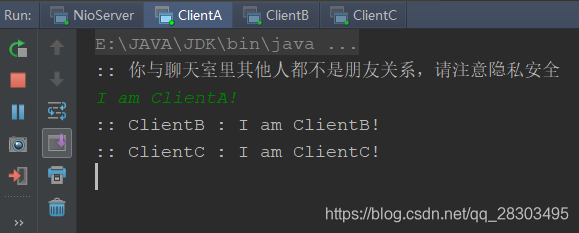社区微信群开通啦,扫一扫抢先加入社区官方微信群

社区微信群
社区微信群开通啦,扫一扫抢先加入社区官方微信群

社区微信群
NIO网络编程实战
利用NIO编程知识,实现多人聊天室。
第一步:创建Selector
第二步:创建ServerSocketChannel,并绑定监听端口
第三步:将Channel设置为非阻塞模式
第四步:将Channel注册到Selector上,监听连接事件
第五步:循环调用Selector的select方法,检测就绪情况
第六步:调用selectedKeys方法获取就绪channel集合
第七步:判断就绪事件种类,调用业务处理方法
第八步:根据业务需要决定是否再次注册监听事件,重复执行第三步操作
利用NIO编程知识,实现多人聊天室。

package com.xuxin.niochatroom;
import java.io.IOException;
import java.net.InetSocketAddress;
import java.nio.ByteBuffer;
import java.nio.channels.*;
import java.nio.charset.Charset;
import java.util.Iterator;
import java.util.Set;
/**
* NIO服务器端
*/
public class NioServer {
/**
* 启动
*/
public void start() throws IOException {
// 1. 创建Selector
Selector selector = Selector.open();
// 2. 通过ServerSocketChannel创建channel通道
ServerSocketChannel serverSocketChannel = ServerSocketChannel.open();
// 3. 为channel通道绑定监听端口
serverSocketChannel.bind(new InetSocketAddress(8000));
// 4. 设置channel为非阻塞模式
serverSocketChannel.configureBlocking(false);
// 5. 将channel注册到selector上,监听连接事件
serverSocketChannel.register(selector, SelectionKey.OP_ACCEPT);
System.out.println("服务器启动成功!");
// 6. 循环等待新接入的连接
for (;;) {
// 获取可用channel的数量
int readyChannels = selector.select();
if (readyChannels == 0) {
continue;
}
// 获取可用channel的集合
Set<SelectionKey> selectionKeys = selector.selectedKeys();
Iterator iterator = selectionKeys.iterator();
while(iterator.hasNext()) {
// selectionKey实例
SelectionKey selectionKey = (SelectionKey) iterator.next();
// 移除Set中的当前selectionKey
iterator.remove();
// 7. 根据就绪状态,调用对应方法处理业务逻辑
// 如果是 接入事件
if (selectionKey.isAcceptable()) {
acceptHandler(serverSocketChannel, selector);
}
// 如果是 可读事件
if (selectionKey.isReadable()) {
readHandler(selectionKey, selector);
}
}
}
}
/**
* 接入事件处理器
*/
private void acceptHandler(ServerSocketChannel serverSocketChannel,
Selector selector) throws IOException {
// 如果要是接入事件,创建socketChannel
SocketChannel socketChannel = serverSocketChannel.accept();
// 将socketChannel设置为非阻塞工作模式
socketChannel.configureBlocking(false);
// 将channel注册到selector上,监听 可读事件
socketChannel.register(selector, SelectionKey.OP_READ);
// 回复客户端提示信息
socketChannel.write(Charset.forName("UTF-8")
.encode("你与聊天室里其他人都不是朋友关系,请注意隐私安全"));
}
/**
* 可读事件处理器
*/
private void readHandler(SelectionKey selectionKey, Selector selector)
throws IOException {
// 要从selectionKey中获取到已经就绪的channel
SocketChannel socketChannel = (SocketChannel) selectionKey.channel();
// 创建buffer
ByteBuffer byteBuffer = ByteBuffer.allocate(1024);
// 循环读取客户端请求信息
String request = "";
while (socketChannel.read(byteBuffer) > 0) {
// 切换buffer为读模式
byteBuffer.flip();
// 读取buffer中的内容
request += Charset.forName("UTF-8").decode(byteBuffer);
}
// 将channel再次注册到selector上,监听他的可读事件
socketChannel.register(selector, selectionKey.OP_READ);
// 将客户端发送的请求信息 广播给其他客户端
if (request.length() > 0) {
// 广播给其他客户端
broadCast(selector, socketChannel, request);
}
}
/**
* 广播给其他客户端
*/
private void broadCast(Selector selector, SocketChannel sourceChannel, String request) {
// 获取到所有已接入的客户端channel
Set<SelectionKey> selectionKeySet = selector.keys();
// 循环向所有channel广播信息
selectionKeySet.forEach(selectionKey -> {
Channel targetChannel = selectionKey.channel();
// 剔除发消息的客户端
if ((targetChannel instanceof SocketChannel) && (targetChannel != sourceChannel)) {
try {
// 将信息群发给target的客户端
((SocketChannel) targetChannel).write(Charset.forName("UTF-8").encode(request));
} catch (IOException e) {
e.printStackTrace();
}
}
});
}
/**
* 主程序
* @param args
*/
public static void main(String[] args) throws IOException {
NioServer nioServer = new NioServer();
nioServer.start();
}
}
package com.xuxin.niochatroom;
import java.io.IOException;
import java.net.InetSocketAddress;
import java.nio.channels.SelectionKey;
import java.nio.channels.Selector;
import java.nio.channels.SocketChannel;
import java.nio.charset.Charset;
import java.util.Scanner;
/**
* NIO客户端
*/
public class NioClient {
/**
* 启动
*/
public void start(String nickName) throws IOException {
// 连接服务器
SocketChannel socketChannel = SocketChannel.open(
new InetSocketAddress("127.0.0.1", 8000)
);
// 接收服务器端响应
// 创建线程,专门负责接收服务器端的响应数据
// selector socketChannel 注册
Selector selector = Selector.open();
socketChannel.configureBlocking(false);
socketChannel.register(selector, SelectionKey.OP_READ);
new Thread(new NioClientHandler(selector)).start();
// 向服务器端发送数据
Scanner scanner = new Scanner(System.in);
while (scanner.hasNextLine()) {
String request = scanner.nextLine();
if ((request != null) && (request.length() > 0)) {
socketChannel.write(Charset.forName("UTF-8").encode(nickName + " : " + request));
}
}
}
}
package com.xuxin.niochatroom;
import java.io.IOException;
import java.nio.ByteBuffer;
import java.nio.channels.SelectionKey;
import java.nio.channels.Selector;
import java.nio.channels.SocketChannel;
import java.nio.charset.Charset;
import java.util.Iterator;
import java.util.Set;
public class NioClientHandler implements Runnable {
private Selector selector;
public NioClientHandler(Selector selector) {
this.selector = selector;
}
@Override
public void run() {
try {
// 1. 循环等待服务器端响应
for (; ; ) {
// 获取可用channel的数量
int readyChannels = selector.select();
if (readyChannels == 0) {
continue;
}
// 获取可用channel的集合
Set<SelectionKey> selectionKeys = selector.selectedKeys();
Iterator iterator = selectionKeys.iterator();
while (iterator.hasNext()) {
// selectionKey实例
SelectionKey selectionKey = (SelectionKey) iterator.next();
// 移除Set中的当前selectionKey
iterator.remove();
// 7. 根据就绪状态,调用对应方法处理业务逻辑
// 如果是 可读事件
if (selectionKey.isReadable()) {
readHandler(selectionKey, selector);
}
}
}
} catch (IOException e) {
e.printStackTrace();
}
}
/**
* 可读事件处理器
*/
private void readHandler(SelectionKey selectionKey, Selector selector)
throws IOException {
// 要从selectionKey中获取到已经就绪的channel
SocketChannel socketChannel = (SocketChannel) selectionKey.channel();
// 创建buffer
ByteBuffer byteBuffer = ByteBuffer.allocate(1024);
// 循环读取服务器端的响应数据
String reponse = "";
while (socketChannel.read(byteBuffer) > 0) {
// 切换buffer为读模式
byteBuffer.flip();
// 读取buffer中的内容
reponse += Charset.forName("UTF-8").decode(byteBuffer);
}
// 将channel再次注册到selector上,监听他的可读事件
socketChannel.register(selector, selectionKey.OP_READ);
// 将服务器端的响应数据打印到本地
if (reponse.length() > 0) {
System.out.println(":: " + reponse);
}
}
}
ClientA:
package com.xuxin.niochatroom;
import java.io.IOException;
public class ClientA {
public static void main(String[] args) throws IOException {
new NioClient().start("ClientA");
}
}
ClientB:
package com.xuxin.niochatroom;
import java.io.IOException;
public class ClientB {
public static void main(String[] args) throws IOException {
new NioClient().start("ClientB");
}
}
ClientC:
package com.xuxin.niochatroom;
import java.io.IOException;
public class ClientC {
public static void main(String[] args) throws IOException {
new NioClient().start("ClientC");
}
}
启动服务器端

启动ClientA、ClientB、ClientC,并先由ClientA开始输入聊天信息,再由ClientB开始输入聊天信息,最后由ClientC开始输入聊天信息



NIO类库和API繁杂。需要了解ServerSocketChannel、SocketChannel、ByteBuffer等核心类库的使用
可靠性能力补齐,工作量和难度都非常大。
客户端的断连、重连、网络闪断、失败缓存、网络阻塞和异常码流等问题。
Selector空轮询,导致CPU100%。
如果觉得我的文章对您有用,请随意打赏。你的支持将鼓励我继续创作!
